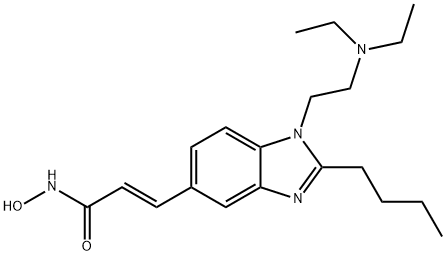Pracinostat

|
- ₹0
- Product name: Pracinostat
- CAS: 929016-96-6
- MF: C20H30N4O2
- MW: 358.48
- EINECS:
- MDL Number:MFCD17215206
- Synonyms:Pracinostat (SB939);SB939;(2E)-3-[2-Butyl-1-[2-(diethylaMino)ethyl]-1H-benziMidazol-5-yl]-N-hydroxy-2-propenaMide;(2E)-3-[2-Butyl-1-[2-(diethylaMino)ethyl]-1H-benziMidazol-5-yl]-N-hydroxyacrylaMide;(E)-3-[2-Butyl-1-(2-diethylaMinoethyl)-1H-benziMidazol-5-yl]-N-hydroxy-2-propenaMide;KaeMpferol 3-O-β-D-(6-E-p-CouMaroylglucoside);Pracinostat;2-Propenamide, 3-[2-butyl-1-[2-(diethylamino)ethyl]-1H-benzimidazol-5-yl]-N-hydroxy-, (2E)-
| Manufacturer | Product number | Product description | Packaging | Price | Updated | Buy |
|---|
Properties
Density :1.11
storage temp. :Store at -20°C
solubility :insoluble in H2O; ≥11.4 mg/mL in DMSO; ≥24.8 mg/mL in EtOH with ultrasonic
form :solid
pka :8.67±0.23(Predicted)
color :White to light brown
storage temp. :Store at -20°C
solubility :insoluble in H2O; ≥11.4 mg/mL in DMSO; ≥24.8 mg/mL in EtOH with ultrasonic
form :solid
pka :8.67±0.23(Predicted)
color :White to light brown
Safety Information
| Symbol(GHS): |

|
||||||||||||||||||||||||||||||
|---|---|---|---|---|---|---|---|---|---|---|---|---|---|---|---|---|---|---|---|---|---|---|---|---|---|---|---|---|---|---|---|
| Signal word: | Warning | ||||||||||||||||||||||||||||||
| Hazard statements: |
|
||||||||||||||||||||||||||||||
| Precautionary statements: |
|
Description
Inhibition of histone deacetylases (HDACs) leads to accumulation of acetylated histones, resulting in a variety of cell type-dependent responses including apoptosis, necrosis, differentiation, cell survival, inhibition of proliferation, and cytostasis. SB939 is an HDAC inhibitor that displays an IC50 value of 77 nM in an in vitro HDAC1 activity assay and prevents proliferation of ovarian (A2780), colon (COLO 205 and HCT-116), and prostate cancer (PC-3) cell lines at IC50 values of 0.48, 0.56, 0.48, and 0.34 μM, respectively. SB939 is a pan-HDAC inhibitor binding all HDAC isozymes with similar affinity (Kis = 16-28 nM) with the exception of HDAC6 and 7 (Kis = 247 and 104 nM, respectively). SB939 demonstrates good bioavailability in vivo and significantly inhibits tumor growth in various xenograft mouse models at doses ranging from 25-100 mg/kg. It is being evaluated in phase I and phase II clinical trials in both hematological and solid tumor patients.More related product prices
4-Methyl-2-pentanone HEXABUTYLDITIN 726169-73-9 JNJ-26481585 Panobinostat ACY-1215 ML264 BAY 11-7085 (2E)-3-(4'-Hydroxy-3'-tricyclo[3.3.1.13,7]dec-1-yl[1,1'-biphenyl]-4-yl)-2-propenoic acid WP1130 WP1066 1164470-53-4 694433-59-5 SB 225002 SB 203580 SB-705498 Entinostat 472981-92-3 356559-20-1 405554-55-4Related product price
- 4-Methyl-2-pentanone
₹460-424970.01 - HEXABUTYLDITIN
₹1731-59918 - BAY 11-7085
₹7300-24800






